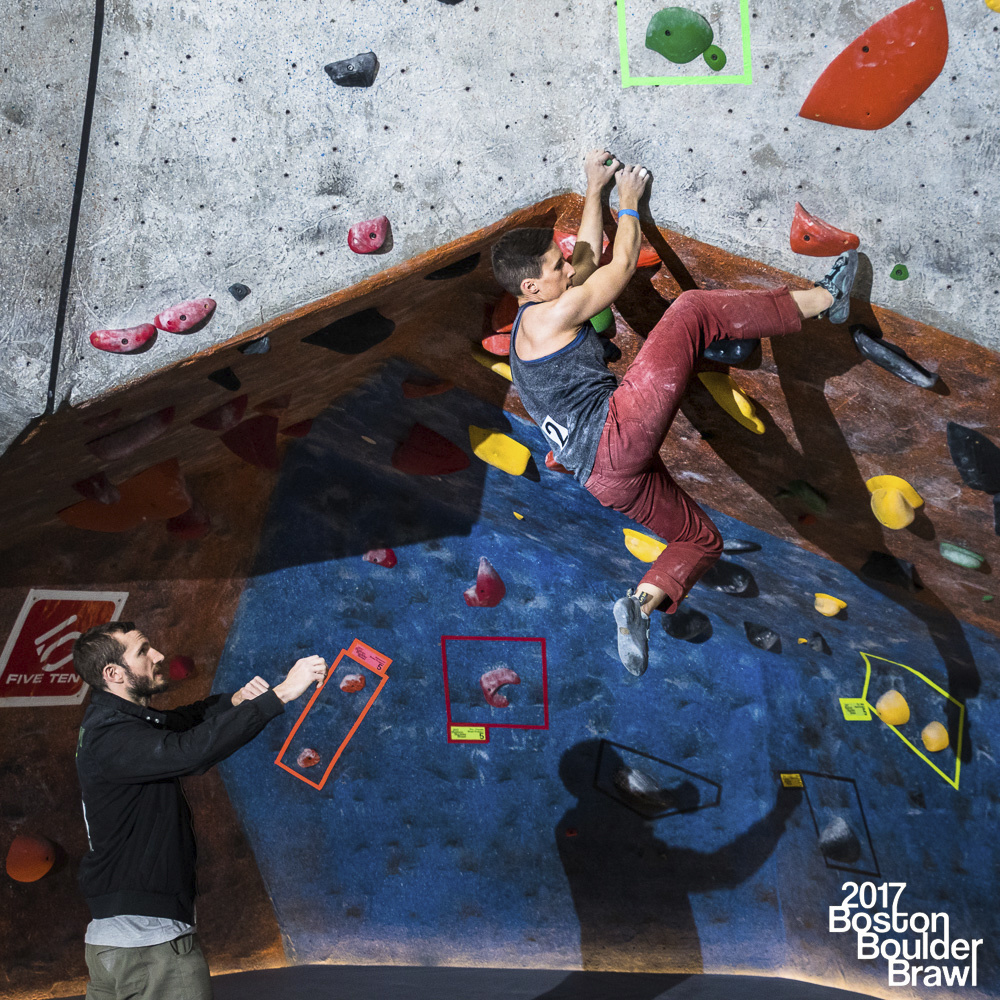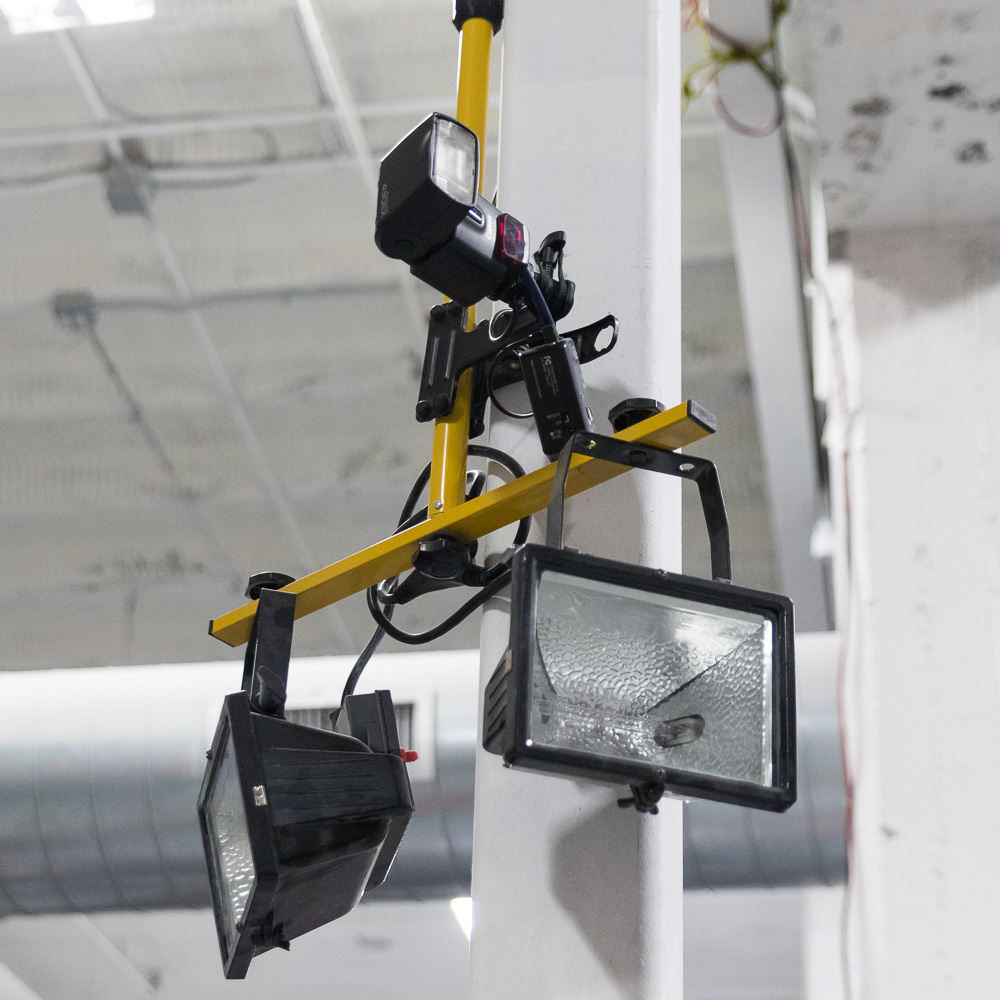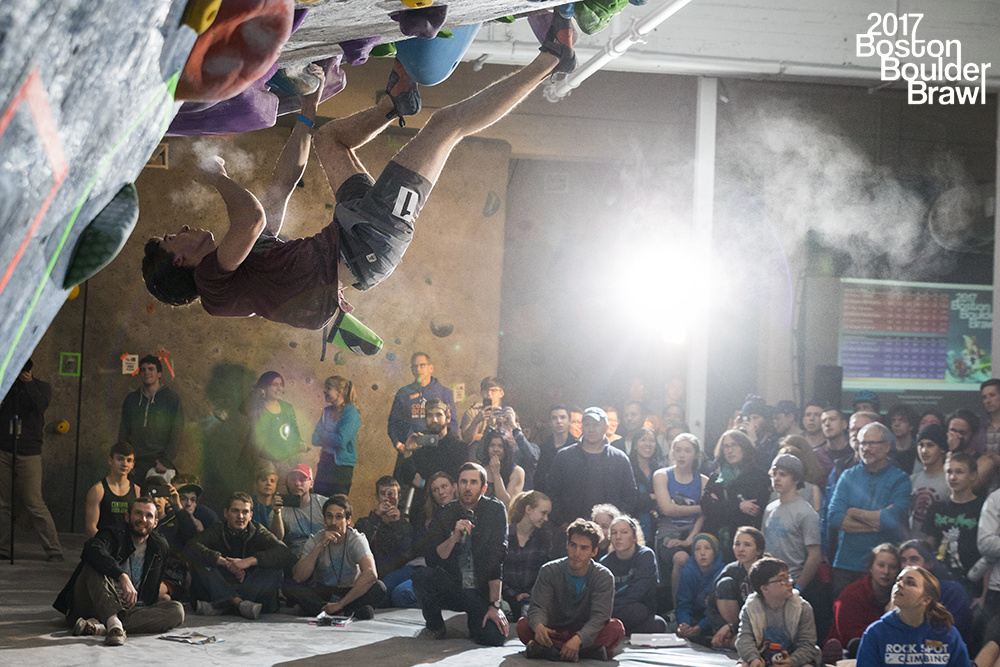I spend a couple days a week inside a rock climbing gym when I’m not traveling. So when I got the opportunity to photograph Rock Spot Climbing's Boston Boulder Brawl, one of the bigger local bouldering competitions, I got really excited. As an adventure photographer I've photographed climbing in all sorts of environments but this would be my first attempt at shooting indoor climbing. Of course indoor gyms come with a completely different set of difficulties compared to shooting outdoors.
If you're not familiar with bouldering it's a form of climbing done without ropes and harnesses, often at lower 30 foot heights. What started off as a training technique has quickly become an extremely popular competitive sport and is even going to be added into the 2020 Tokyo Olympics along with sport and speed climbing.

With only a couple of days to prepare I knew there were two things I wanted to accomplish: lighting with strobes and setting up remote cameras.
Having been in the gym before I was familiar with the layout and lighting conditions. If you've ever been to an indoor gym of any type you know the lighting is horrible with mostly fluorescent or tungsten lights hung high above often with mixed sources. So the first thing on my wish list was bringing my own lights. With the OK to bring lighting and only using what I had on hand it was going to have to be speedlights. Setting up and running cables for strobes just didn't seem worth it and I didn't have time to arrange for some of the newer more portable battery strobes like the Profoto B1s. The next time I try this, however, I will probably go that route or at least a mix of the two.

The preliminary rounds were done with all the house lights on and in a different part of the gym so I had no lighting set up there. You can see in the images below that the lighting is really flat and washes out on the wall showing no texture. Not having light here was disappointing since this was where I ended up photographing most of the junior climbers. These young climbers were amazing with so much talent.


Flat Lighting from Gym Florescents
For the finals area I set up two speedlights, but because I was also planning on setting up at least one remote camera, Pocket Wizards became the limiting factor. I had enough older Plus IIs to rig up two lights and one remote camera. This is another area next time I will double up my efforts. The final zone was shaped like a horseshoe with six climbing zones. So I set the lights up on either side feathered towards the middle. They were set to different channels at 1/16 power so I could swap back and forth. This way I could get the most versatility between the six zones.

Overall Im very happy with how the lights performed. I expected to have to swap out the batteries at least once or have really slow recycling times but his wasn't the case and having them set to 1/16 power probably helped a lot with that. For mounting I used a Manfrotto A-clamp for one and put the second up on a light stand tucked up against a center column in the middle of the room. Once the finals started and the crowds moved in I really couldn't make angle adjustments or troubleshoot any problems. I did have a few missed pops towards the end but I probably was starting to really push them at that point.

Speedlight Mounted with Pocket Wizard
Having figured out the lighting I moved onto setting up my remote camera rig. I have worked with remote cameras on different projects previously, however this was my first time triggering it from my main camera. Meaning for every press of the shutter on the camera in my hands the remote camera was also triggered. This was pretty cool but definitely a learning experience for me. I spent time climbing behind all the walls picking my locations based on what looked interesting to me. This backfired since I wasn't paying attention to who would be climbing each route. The best location and first one I tried ended up pointing to the top out holds for the junior finals, but most never managed to make it that far. I rushed to set up a second location in between rounds but unfortunately all my planning was for nothing. I got a few cool shots from the climbers that did manage to complete the climb and learned a good lesson.

Below you can see the difference between the house lighting and the hot lights set up for finals. It's clear the speedlights provided the best results.
The remote rig was made up of another Pocket Wizard Plus II connected to the camera with Pocket Wizard’s sync cable. For mounting I used a Manfrotto Super-Clamp plus ball joint and camera plate combo to give me the most flexibility. I also brought along a Manfrotto Magic Arm but didn't end up needing it. I made a DIY safety cable for securing the camera to the wall supports. This was more a safety measure for the climbers than the gear as the Manfrotto stuff is rock solid and I had no doubts in it holding. The last thing was some gaffer tape to lock in the focus because gravity tends to move the lens over time.

Here you can see the remote camera set up. Also just how much chalk dust was on everything

Everything you need to set up a basic remote camera rig
Conclusion
As mentioned above, the strobe lighting really was the biggest key to getting better photos. I really like the hard side light casting shadows on all the holds and creating texture on the wall. If you have to shoot in a climbing gym like this it's definitely the way to go. My suggestion of course is to set up as many lights as you can. Take advantage of the different channels so you can move through the gym only triggering the lights you need. I'd love to try some cross lighting with a little fill and I think that will be my next trial.
The remote camera rig worked out amazing. It triggered every time even though I had no way of checking it until the end. I think if you're going to go wide angle then go really wide. However I think a 100mm-plus lens would give you some great close ups of that excitement when a climber tops out. Make sure to put a lot of thought into your placement. Not just in how the shot lines up but what climber will be on that route and what is the difficulty of it. You want to be sure climbers will be making it to the top and into view.



If you make it into Finals you have to show off a little
The Boston Boulder Brawl was a great event and all the climbers were just amazing. If you're in the New England area and looking to climb check out Rock Spot Climbing. They have a bunch of great gyms scattered around.
Let me know what you think in the comments. If you want to see more adventure-based articles let me know by joining the Fstoppers Community Adventure and Sports groups. What type of articles would you like to see?









Great article Mike! Great images, and nice info on the setup.
Thanks Jay
Love your use of lighting in this. I shot the Sport and Speed youth national champs last year and trying to add dramatic lighting to the shots was definetly tough. I'll definitely try your use of small constant lights that aren't intrusive if I shoot indoor climbing again. Having a background in climbing would have been a huge advantage to get some of those angles and know where the climbers would be in their climb. I was able to climb behind the wall and that saved my butt. Nice job.
http://rgrphotography.com/blog/2016/8/9/usa-climbing-speed-and-sport-nat...
Thanks Garrett. You got some great shots from above and the crowd shots look awesome. I shot some from behind the wall but it doesn't have the same effect in bouldering as sport. I agree the lighting really makes a difference but it looks that gym had some nice daylight to help.
Thanks man. Yes that main room had a good bit more light than the back practice rooms.
It really is a pain to shoot in a climbing gym without lights, they are often very dark and so. However, I could imagine some being disturbed by the flashes? Or where they on low enough power to not disturb? Like I can imagine it not being to nice to have a strong flash in your face when doing a dyno or a "risky" move. Did you have any of the climbers complain or so, its defentivly the way to get best looking images, but I can also see people wanting to avoid using them.
The climbers didn't seem to notice at all and the pros are use to it. I ran some test runs with a few climbers before hand. The lights are a good distance from the walls and high plus they were already climbing under bright spot lights.
Yeah this was my thought too, I shoot a bit of skateboarding and when a skater is concentrating on their move they are usually so focused that they didn't even see the flash go off.
Great article! My son just got into competitive climbing and I would love some suggestions on camera and how to reduce blur. Thanks!!